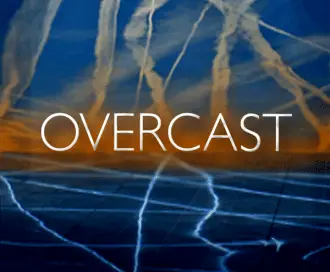1st September 2016
Contributing writer for Wake Up World
As the debate continues to rage about whether or not chemtrails/geoengineering are in fact occurring, the impact of contrails (normal exhaust from aircraft that create a trail of water vapor, ice and soot) on the environment and weather is often overlooked. While the theory of covert chemical spraying operations takes center stage, are we missing a key piece of the puzzle?
Maybe the focus shouldn’t be: Is the military secretly spraying toxic chemicals into the atmosphere? But rather, if contrails from standard air traffic are the real culprit damaging the environment and human health. A concerned filmmaker set out to find the answer.
Following the (Toxic) Trail
“Putting all speculations aside, I wanted a convincing answer.” ~ Matthias Hancke, director of “Overcast”
[pro_ad_display_adzone id=”110028″]
When Hancke embarked on a journey to uncover the truth about chemtrails, he didn’t realize it would take over six years of research — and 40 interviews in 10 countries — to find an answer. His approach is unique as he didn’t have an opinion about chemtrails, one way or another, and kept personal bias out of the investigation. He and producer Tristan Albrecht interviewed a range of experts in the field, along with independent researchers — including: geoengineers, atmospheric chemists, contrail and cloud specialists, professors of aeronautics, meteorologists, aerosol experts, a chemtrail debunker, environmental activists, journalists, a medical doctor, an airline pilot, the assistant director of the Swiss Federal Office for the Environment and more.
One well-known chemtrail debunker interviewed in the film is Mick West, founder of Contrail Science and Metabunk, who believes that the idea of chemtrails is getting in the way of real problems like pollution and global warming. He says there is absolutely no proof of chemical spraying, and that the theory of chemtrails is completely dependent on our perceptions at any given time. West also makes the point that there’s no reason for the government to be doing it secretly, especially if they don’t know the outcome or effects.
This last statement is interesting in the context of an article written by the late Dr. Ilya Sandra Perlingieri, who gives several examples of aerosol spraying programs by the U.S. government in the past. The first was called Manhattan-Rochester Coalition, where aerosol tests were conducted to study “the health [?] effects of radioactive materials…on vulnerable populations without consent in St. Louis.” These military-sponsored [radioactive] “studies targeted a segregated, high density urban area, where low-income persons of color predominantly resided.”
The second took place a few years ago in the subway system of New York City, where unsuspecting riders were sprayed with a toxic gas. Signs were posted that read: “The NYPD [New York Police Dept.] will release small amounts of harmless colorless gas in 5 boroughs and 21 subway lines. The airborne non-toxic [sic] test is part of NYPD’s precaution against terror attacks. MTA [Metropolitan Transit Authority].” Unfortunately for the subway riders, the gas (perfluorocarbon) is far from harmless and has been linked with “early onset menopause, birth defects, flu-like symptoms; endocrine disruption; and “excessive exposure may cause effects on the brain and heart.”’
Another example of covert spraying of the population was a germ warfare experiment in the 1950s, where “the Army sprays a vast cloud of Serratia marcescens over the Bay Area from a vessel in the waters off San Francisco. The bacteria blanketed the city and surrounding communities in a circle from Sausalito through the East Bay to Colma. Shortly after the spraying, 11 patients at the old Stanford University Hospital in San Francisco develop unusually tough infections, and one dies. Serratia destroyed the heart valves of Edward Nevin, 75,” writes John Blanchard for the San Francisco Chronicle.
All three cases of secret spraying were sanctioned by the government, where the outcome or effects were unknown when they began. But, unfortunately, West isn’t the only person who doesn’t question the transparency of the government in the film.
Well-respected institutions like the German Aerospace Center do not test for aluminum, barium or strontium in the atmosphere because there is “no reason for it to be there, how would it get up there in the first place?” In fact, none of the leading organizations studying contrails test for the suspected chemicals. And yet, public authorities, media, politicians and NGOs — as well as environmental groups — all refer to these institutions and don’t test themselves.
This is curious because, as early as 1994, scientists frequently detected aluminum, barium, carbon and titanium in the vicinity of cirrus clouds over Colorado and Wyoming — and attributed it to air transport in the region. Hancke asks: “So why were scientists looking for these particles back then, but not now?”
Eventually, Hancke hires a scientist and special plane to take samples. Due to restrictions by air traffic control during the flight, the plane wasn’t able to gain enough altitude to travel directly through the jet trail, but they did take samples nonetheless. Barium was found to be present. Regrettably, the samples were too small to establish solid evidence.
However, in a fortunate turn of events, The Swiss Federal Institute of Technology in Zurich launched a study of the exhaust of aircrafts. What they found was a total of sixteen different metals in the jet fuel and exhaust of three planes — some of which are extremely toxic to humans, plants and animals —such as aluminum and barium. These two particular metals in the exhaust are due to kerosene in engine lubricant oil. Aluminum can come from the turbines as well. But they found the jet fuel also contained aluminum and barium. We may ask why these metals are in the fuel to begin with, but, speculation aside, “It is in any case urgent to regulate jet engine exhaust,” said Prof Ulrike Lohmann of the Swiss Federal Institute of Technology.
OVERCAST Prof Ulrike Lohmann (English) – aluminum and barium in jet fuel
The findings are worrying, especially since flight traffic has doubled in the last 15 years — and is expected to double again within the next twenty. Another concern is the creation of cloud cover. As stated in the film, “Manmade cloud cover by flight traffic has a bigger impact on global warming in one single year than all the CO2 emitted in the history of aviation.” In Britain alone, this manmade cloud cover can obstruct sunlight over 20,000 square miles. According to the press release for Overcast:
“Considering that there are 37.5 million of aircrafts in the air annually (according ATAG Air Transport Action Group, 2014), we should find out the impact of the emissions of these pollutants on our ecosystem. We should consider also, that with the rain, these substances end up in our food chain and are taken up by organisms. For the protection of the climate and to benefit our health and the environment, we should now make arrangements to banish this metal pollution from our airspace and finally regulate aircraft exhaust pollution.”
To watch the full-length film, visit: Overcast the Movie.
If you would like to learn more about the theory behind chemtrails and geoengineering, see here for a collection of articles on the subject. Additionally, a full transcript of the interview with Mick West can be found here.
Overcast Trailer
Overcast Trailer from Dedal Films on Vimeo.
Article sources:
- www.overcast-the-movie.com
- www.geoengineeringwatch.org/upcoming-documentary-film-overcast-will-address-the-critical-climate-engineering-issue
- www.indiegogo.com/projects/overcast-the-movie#
- www.sfgate.com/health/article/Serratia-has-dark-history-in-region-Army-test-2677623.php
About the author:
 Carolanne Wright enthusiastically believes if we want to see change in the world, we need to be the change. As a nutritionist, natural foods chef and wellness coach, Carolanne has encouraged others to embrace a healthy lifestyle of organic living, gratefulness and joyful orientation for over 13 years.
Carolanne Wright enthusiastically believes if we want to see change in the world, we need to be the change. As a nutritionist, natural foods chef and wellness coach, Carolanne has encouraged others to embrace a healthy lifestyle of organic living, gratefulness and joyful orientation for over 13 years.
Through her website Thrive-Living.net, she looks forward to connecting with other like-minded people from around the world who share a similar vision. You can also follow Carolanne on Facebook, Twitter and Pinterest.
Further reading from Carolanne Wright:
- The Most Eco-Friendly Nation on the Planet is Now Carbon Negative
- Plastic Waste in the Ocean Will Outnumber Fish by 2050
- Mind Control, Subliminal Messages and the Brainwashing of America
- Monsanto Charged with Crimes Against Nature and Humanity – Set to Stand Trial in 2016
- Plastic-Eating Mushroom Discovered in the Amazon Rainforest — A Solution for Our Trash Saturated World?
- Over 100 Scientific Studies Agree: Cannabis Annihilates Cancer
- Why Every Parent Should Consider Unschooling
- First U.S. City Produces More Electricity Than It Uses — With 100% Renewable Technology
- If You Care About Animals and the Earth, Here’s Why You Need to Boycott Palm Oil Immediately
- Basic Income Guarantee: A Surprisingly Cost-Effective Method for Eliminating Poverty
[pro_ad_display_adzone id=”110027″]







